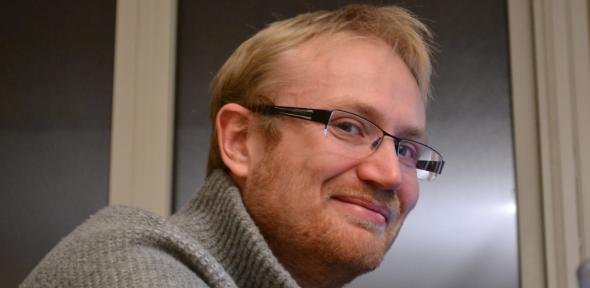
The faculty is proud to welcome Claude Warnick, a lecturer with a joint appointment in the Department of Applied Mathematics and Theoretical Physics and the Department of Pure Mathematics and Mathematical Statistics. What kind of research does such an inter-departmental position entail?
For teaching there is a lot of value on being able to draw on aspects from many different places. When trying to explain a concept, the more ways you can explain it, the better chance students have of understanding. Claude Warnick
To modern eyes the boundary between pure mathematics on the one hand and applied mathematics and physics on the other can seem like a rigid line. The Faculty has been divided along this line and many mathematicians place themselves firmly into one of the two camps. The famous Cambridge number theorist GH Hardy even prided himself on the (supposed) lack of applicability of pure maths. "The 'real' math of the 'real' mathematicians, the mathematics of Fermat and Euler and Gauss and Abel and Riemann, is almost wholly 'useless'," he wrote in A Mathematician's Apology.
In reality ideas have always crossed the boundary between pure maths and physics. The geometric notions developed by Bernhard Riemann and mentioned by Hardy, though not inspired by physical problems, turned out to be exactly what Albert Einstein needed for his general theory of relativity, to describe the curvature of spacetime induced by matter. Considerations of mathematical symmetry have predicted the existence of fundamental particles of nature, including the famous Higgs boson, and continue to lead the way in theoretical physics.
Perhaps less famously, ideas have also flowed in the other direction, especially in recent decades. A beautiful example comes from physicists' approach to explore an object by bombarding it with particles and seeing how they scatter, as happens in particle colliders. The idea inspired mathematicians to explore geometric objects by letting hypothetical particles (or strings from string theory), described by mathematical formulae, move around on them. The approach eventually helped them answer questions in pure geometry that had been open for a hundred years.
A foot in each camp
Warnick's appointment by both departments acknowledges the non-trivial intersection of pure maths and physics. "It's a very natural thing to blur the lines and I think there have always been people who have worked on both sides of the boundary." Warnick's research concerns the malleable nature of spacetime, as predicted by Einstein's famous theory and mentioned above. "I work on partial differential equations and general relativity," he explains. "Partial differential equations describe how a physical quantity varies depending on two or more continuous quantities. [General relativity] is our theory to describe [the force of gravity]."
In Warnick's case the link between the two rests on a phenomenon we're all familiar with: waves. "The fact that you can hear me is down to the fact that sound waves are propagating through the air in this room," says Warnick. Waves, including sound waves, can be described by partial differential equations, and it's these wave equations that Warnick is interested in. "One of the most interesting things about [general relativity] is that [its central equation] is very similar in character to the wave equation that describes sound," he explains. The equivalent of sound waves moving through air are gravitational waves. First predicted by Einstein around a 100 years ago, these waves are ripples in the fabric of spacetime that originate from gravitational events, such as the collisions of massive black holes. The detection of gravitational waves in 2015 was one of the major breakthroughs in modern physics.
"My research [explores] the kind of equations that link these phenomena: wave equations and also problems to do with gravity and general relativity," says Warnick. "The kind of work I am interested in naturally has aspects that are pure mathematical. [In] the study of partial differential equations one has to do a fair amount of analysis and one wants to prove rigorous theorems where possible. On the other hand [what we] are interested in are questions like how black holes behave or how gravitational radiation propagates through the Universe. These are very physical questions, so it's very natural to have a foot in both camps."
Teaching from many angles
In terms of his research a joint lectureship is a natural choice for Warnick, but he thinks that his teaching also stands to benefit. "The boundary between pure and applied maths is not a rigid line," he says. "For teaching there is a lot of value in being able to draw on aspects from many different places. When trying to explain a concept, the more ways you can explain it, the more ways you can link it to other parts of mathematics, the better chance students have of understanding. From the point of teaching it's a valuable thing to be able to link the two departments."
Warnick, who completed is undergraduate degree and PhD in Cambridge, will be working with other researchers based in both DPMMS and DAMTP. He returns to the Faculty at a time of spectacular advances in his field. "The most exciting recent development in my field is the direct measurement of gravitational waves. [Their existence] has been conjectured for many decades and only now do we have direct experimental evidence to show that [they do] exist. It's a really exciting time because [gravitational waves] open a window on gravitational physics and a window on the Universe. I think a tremendous amount of interesting data will come out of [gravitational wave] experiments in the near future. I'm really looking forward to where this discovery will go in the next few years."
You can find out more about gravitational waves, and the role of Faculty researchers in their discovery, in this feature. To find out more about the impact of physics on pure mathematics, watch this lecture by David Tong, Professor of Theoretical Physics at DAMTP.
